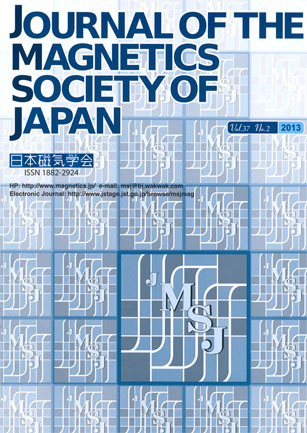
- Issue 6 Pages 105-
- Issue 5 Pages 91-
- Issue 4 Pages 70-
- Issue 3 Pages 42-
- Issue 2 Pages 17-
- Issue 1 Pages 6-
- |<
- <
- 1
- >
- >|
-
S. Takeda, H. Kijima-Aoki, H. Masumoto, H. Suzuki2019 Volume 43 Issue 5 Pages 91-98
Published: September 01, 2019
Released on J-STAGE: September 01, 2019
Advance online publication: July 23, 2019JOURNAL OPEN ACCESSIn this study, the high frequency permeability (μ) and ferromagnetic resonance(FMR) phenomena of a thin film with a strong perpendicular magnetic anisotropy and in-plane magnetically isotropic properties was measured using the short-circuited coaxial line technique; the analyzed sample had a toroidal shape. A field method was used for the background correction, where a strong magnetic bias field was applied and removed. However, when using a short-circuited coaxial line, the μ=1 condition cannot be achieved beyond a few ten GHz frequencies, whereas ferromagnetic resonance (denoted as FMR2) occurred because of the insufficient bias field. This resonance was compensated using the Landau-Lifshitz-Gilbert (LLG) equation, and the net μ-f properties without the bias field (denoted as FMR1) up to 30 GHz successfully extracted. Finally, a good agreement between the experimental results and the calculations based on the assumption of a magnetic multi-domain structure in FMR1 was achieved.
View full abstractDownload PDF (1049K)
-
T. Takura, S. Kajiwara, H. Kikuchi, H. Matsuki2019 Volume 43 Issue 5 Pages 99-104
Published: September 01, 2019
Released on J-STAGE: September 01, 2019
Advance online publication: July 23, 2019JOURNAL OPEN ACCESSThe soft-heating method is an implantable hyperthermia method that can control the ultimate temperature of heating elements by using the Curie temperature of the magnetic material used in the element. It is a safe heating method. High heat generation has been achieved for heating elements by forming a metal ring around a core made of a ferrite-based magnetic material having a low Curie temperature. However, to generate a magnetic flux for heating deep inside the body, an exciting coil with a high withstand voltage and large allowable current has been required. In this research, we reduce the load on the exciting system, by developing a novel heating element using the LC-booster method. This wireless power transfer technology is excellent in matching with the load resistance and is proposed as a method for improving the performance of the heating element itself. Our proposed LC-booster method has better heat generation performance than the conventional methods. In addition, we prove that the performance could be improved by increasing the resonant frequency.
View full abstractDownload PDF (1318K)
- |<
- <
- 1
- >
- >|